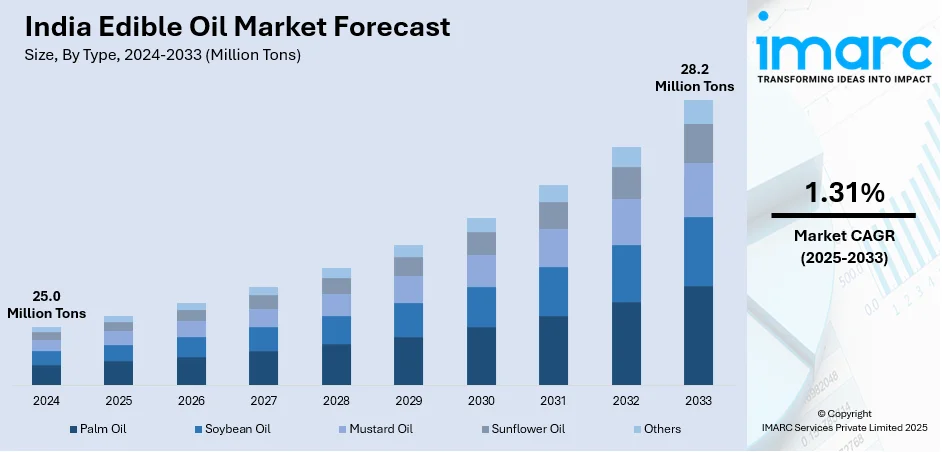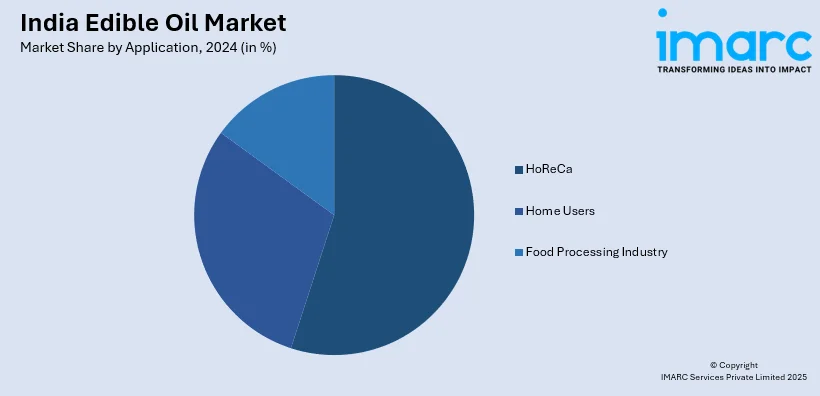
India Edible Oil Market Size, Share, Trends and Forecast by Type, Packaging Type, Packaging Material, Pack Size, Domestic Manufacturing/Imports, Application, Distribution Channel, and Region, 2025-2033
India Edible Oil Market Summary:
The India edible oil market size reached a volume of 25.0 Million Tons in 2024. The market is projected to reach a volume of 28.2 Million Tons by 2033, exhibiting a growth rate (CAGR) of 1.31% during 2025-2033. The market growth is attributed to the rising disposable incomes, increasing health awareness, growing demand for packaged and branded oils, expanding food processing industries, evolving dietary preferences, and government support for oilseed cultivation.
Market Insights:
- On the basis of region, the market is segmented into North India, West and Central India, East India, and South India.
- Based on type, the market is divided into palm oil, soybean oil, mustard oil, sunflower oil, and others.
- On the basis of packaging type, the market is segmented into pouches, jars, cans, and bottles.
- Based on packaging material, the market is divided into metal, plastic, paper, and others.
- On the basis of pack size, the market is segmented into less than 1 litres, 1 litres, 1 litres - 5 litres, 5 litres - 10 litres, and 10 litres and above.
- Based on domestic manufacturing/imports, the market is divided into domestic manufacturing and imports.
- On the basis of application, the market is segmented into HoReCa, home users, and food processing industry.
- Based on distribution channel, the market is divided into direct/institutional sales, supermarkets and hypermarkets, convenience stores, online, and others.
Market Size and Forecast:
- 2024 Market Size: 25.0 Million Tons
- 2033 Projected Market Size: 28.2 Million Tons
- CAGR (2025-2033): 1.31%
India currently represents the world’s largest importer of edible oil in the world. Increasing disposable incomes, rising urbanization rates, changing dietary habits and the growth of the food processing sector represent some of the key factors driving the demand of edible oil in India.

To get more information on this market, Request Sample
In India, the rising consumer health concerns towards the high prevalence of coronary heart diseases, diabetes, obesity, gastrointestinal disorders, etc., are primarily driving the demand for healthy edible oil. Additionally, the market is further catalyzed by the growing awareness towards several health benefits of organic and low-cholesterol edible oil. As a result, various regional manufacturers are launching healthy product variants enriched with omega-3, vitamins, and natural antioxidants. Moreover, the changing consumer dietary patterns and their hectic work schedules have led to the increasing consumption of processed food items. The rising demand for edible oil in the food processing sector as food preservatives and flavoring agents is also supporting the development of India edible oil industry. Additionally, the elevating consumer living standards coupled with the increasing penetration of international culinary trends are further augmenting the demand for high-quality product variants, such as olive oil, sesame oil, flaxseed oil, etc. Apart from this, the expanding agriculture sector along with the launch of several initiatives for enhancing the production of oilseeds in the country is also propelling the market. Furthermore, the Indian government is making continuous efforts to increase the domestic availability of edible oil and reduce import dependency. For instance, the government has proposed the National Mission on Edible Oil (NMEO) for meeting the country’s consumption need for edible oil, such as sesame oil, groundnut oil, safflower oil, palm oil, etc.
India Edible Oil Market Trends:
Rising Edible Oil Consumption Due to Population Growth and Urbanization
India’s edible oil consumption continues to grow steadily, driven by population growth, rising disposable incomes, and urbanization. As per industry reports, India’s population is expected to grow from 1.417 Billion in 2022 to 1.515 Billion by 2030. As the world’s leading importer and consumer, India edible oil demand is closely tied to dietary habits, especially the high reliance on cooking oils in Indian cuisine. Urban households are increasingly favoring ready-to-cook and processed foods, which further amplifies edible oil usage. Moreover, changing dietary preferences and rising meat consumption also indirectly contribute to higher oil intake, given the oil required in food preparation and processing. The expansion of the foodservice industry, including quick-service restaurants, cloud kitchens, and packaged snack producers, has further catalyzed bulk demand. Additionally, the rural market remains vital, with consumption patterns steadily catching up due to improved access, increased awareness, and government welfare distribution of subsidized oils under public distribution schemes.
Increasing Focus on Domestic Production and Import Dependency Reduction
The market is witnessing an increasing focus on increasing domestic production and reducing reliance on imports, which currently account for over 60% of total consumption. Global price volatility, geopolitical tensions, and supply disruptions, especially witnessed during the COVID-19 pandemic, have underscored the vulnerability of India’s edible oil security. In response, the government has rolled out various policy measures, aiming to expand the cultivation of oilseeds like mustard, groundnut, soybean, and oil palm. In addition to this, subsidies, minimum support prices, and infrastructure development support are extended to promote local production, which further supports the growth of edible oil market in India. Additionally, investments are being channeled into research and development (R&D), oilseed processing, and agri-tech innovations to increase yield and reduce post-harvest losses. Private sector players are also entering contract farming and backward integration. This trend reflects a strategic shift towards achieving self-sufficiency and improving the overall sustainability of the edible oil supply chain in India.
India Edible Oil Industry Segmentation:
IMARC Group provides an analysis of the key trends in each sub-segment of the India edible oil market report, along with forecasts at the country and regional level from 2025-2033. Our report has categorized the market based on type, packaging type, packaging material, pack size, domestic manufacturing/imports, application and distribution channel.
Breakup by Type:
- Palm Oil
- Soybean Oil
- Mustard Oil
- Sunflower Oil
- Others
Breakup by Packaging Type:
- Pouches
- Jars
- Cans
- Bottles
Breakup by Packaging Material:
- Metal
- Plastic
- Paper
- Others
Breakup by Pack Size:
- Less than 1 Litres
- 1 Litres
- 1 Litres - 5 litres
- 5 Litres - 10 Litres
- 10 Litres and Above
Breakup by Domestic Manufacturing/Imports:
- Domestic Manufacturing
- Imports
Breakup by Application:

- HoReCa
- Home Users
- Food Processing Industry
Breakup by Distribution Channel:
- Direct/Institutional Sales
- Supermarkets and Hypermarkets
- Convenience Stores
- Online
- Others
Breakup by Region:
- North India
- West and Central India
- East India
- South India
Competitive Landscape:
The report has provided a comprehensive analysis of the competitive landscape in the India edible oil market. Detailed profiles of all major companies have also been provided. Some of the key players in the market include:
- Adani Group
- BCL Industries Ltd.
- Bunge
- Cargill, Incorporated
- Emami Agrotech Ltd
- Gulab Oil & Foods
- Mahesh Edible Oil Industries Limited
- Marico Limited
- N.K Proteins Pvt Ltd
- Patanjali Ayurved Limited
- Sanwaria Consumer Limited
- Sundrop Brands Limited
Latest News and Developments:
- On April 8, 2025, the Solvent Extractors’ Association of India (SEA) entered into a strategic Memorandum of Understanding with TechnoServe to strengthen the fortification of edible oils across India, aligning with FSSAI’s voluntary fortification standards and the nation’s broader nutritional priorities. The partnership will deliver training programs, workshops, and seminars aimed at enhancing the technical capabilities of oil producers, fostering good manufacturing and hygiene practices, and improving both internal and external quality assurance systems.
- On January 29, 2025, KRBL announced the launch of its new edible oil range under the “India Gate Uplife” umbrella, marking its diversification beyond its core basmati rice business. The company introduced two premium blended-oil variants, Gut Pro and Lite, targeting health-conscious consumers. This move is part of KRBL’s broader strategy to expand its product portfolio and appeal to a wider market segment.
- On October 3, 2024, the Union Cabinet approved the National Mission on Edible Oils – Oilseeds (NMEO‑Oilseeds), a seven‑year initiative with a budgetary allocation of INR 10,103 Crore (about USD 1.22 Billion), aiming to bolster domestic oilseed production and achieve self‑reliance in edible oils. The mission targets a significant increase in primary oilseed outputs.
- On July 19, 2024, the Roundtable on Sustainable Palm Oil (RSPO) and the Indian Vegetable Oil Producers’ Association (IVPA) signed a Memorandum of Understanding (MoU) to advocate and implement sustainable palm oil cultivation and imports in India. The collaboration will focus on raising awareness, conducting research, promoting best agricultural practices, and influencing policy support.
Report Coverage:
| Report Features | Details |
|---|---|
| Base Year of the Analysis | 2024 |
| Historical Period | 2019-2024 |
| Forecast Period | 2025-2033 |
| Units | Million Tons |
| Segment Coverage | Type, Packaging Type, Packaging Material, Pack Size, Domestic Manufacturing/Imports, Application, Distribution Channel, Region |
| Region Covered | North India, West and Central India, East India, South India |
| Companies Covered | Adani Group, BCL Industries Ltd., Bunge, Cargill, Incorporated, Emami Agrotech Ltd, Gulab Oil & Foods, Mahesh Edible Oil Industries Limited, Marico Limited, N.K Proteins Pvt Ltd, Patanjali Ayurved Limited, Sanwaria Consumer Limited, Sundrop Brands Limited, etc. |
| Customization Scope | 10% Free Customization |
| Post-Sale Analyst Support | 10-12 Weeks |
| Delivery Format | PDF and Excel through Email (We can also provide the editable version of the report in PPT/Word format on special request) |
Key Questions Answered in This Report
The India edible oil market reached a volume of 25.0 Million Tons in 2024.
We expect the India edible oil market to exhibit a CAGR of 1.31% during 2025-2033.
The rising consumer health consciousness, along with the changing inclination towards organic and low- cholesterol edible oils, is currently driving the India edible oil market.
The sudden outbreak of the COVID-19 pandemic has led to the changing consumer inclination from conventional brick-and-mortar distribution channels towards online retail platforms for the purchase of edible oil.
Based on the type, the India edible oil market has been bifurcated into palm oil, soybean oil, mustard oil, sunflower oil, and others. Currently, palm oil holds the majority of the total market share.
Based on the packaging material, the India edible oil market can be categorized into metal, plastic, paper, and others. Among these, plastic packaging material exhibits clear dominance in the market.
Based on the application, the India edible oil market has been divided into HoReCa, home users, and food processing industry. Currently, home users represent the largest market share.
Based on the distribution channel, the India edible oil market can be segmented into direct/institutional sales, supermarkets and hypermarkets, convenience stores, online, and others. Among these, convenience stores currently account for the majority of the total market share.
On a regional level, the market has been classified into North India, West and Central India, East India, and South India, where West and Central India currently dominates the Indian market.
Need more help?
- Speak to our experienced analysts for insights on the current market scenarios.
- Include additional segments and countries to customize the report as per your requirement.
- Gain an unparalleled competitive advantage in your domain by understanding how to utilize the report and positively impacting your operations and revenue.
- For further assistance, please connect with our analysts.
 Request Customization
Request Customization
 Speak to an Analyst
Speak to an Analyst
 Request Brochure
Request Brochure
 Inquire Before Buying
Inquire Before Buying




.webp)




.webp)












